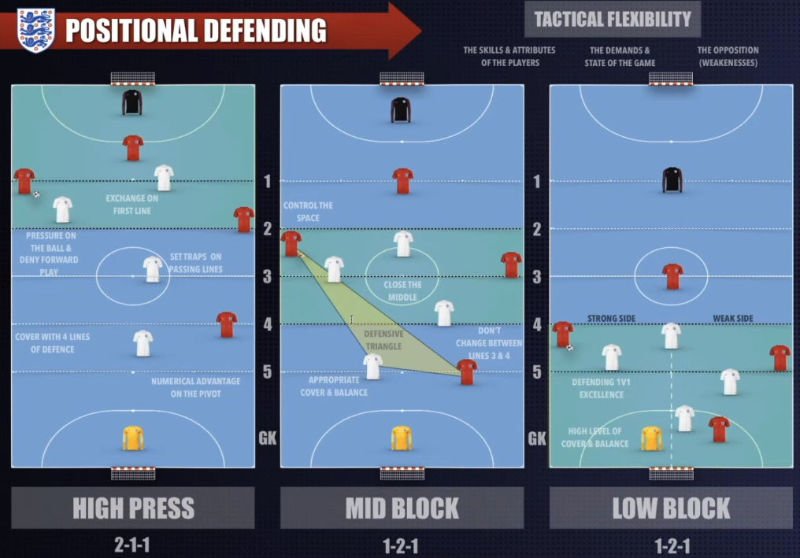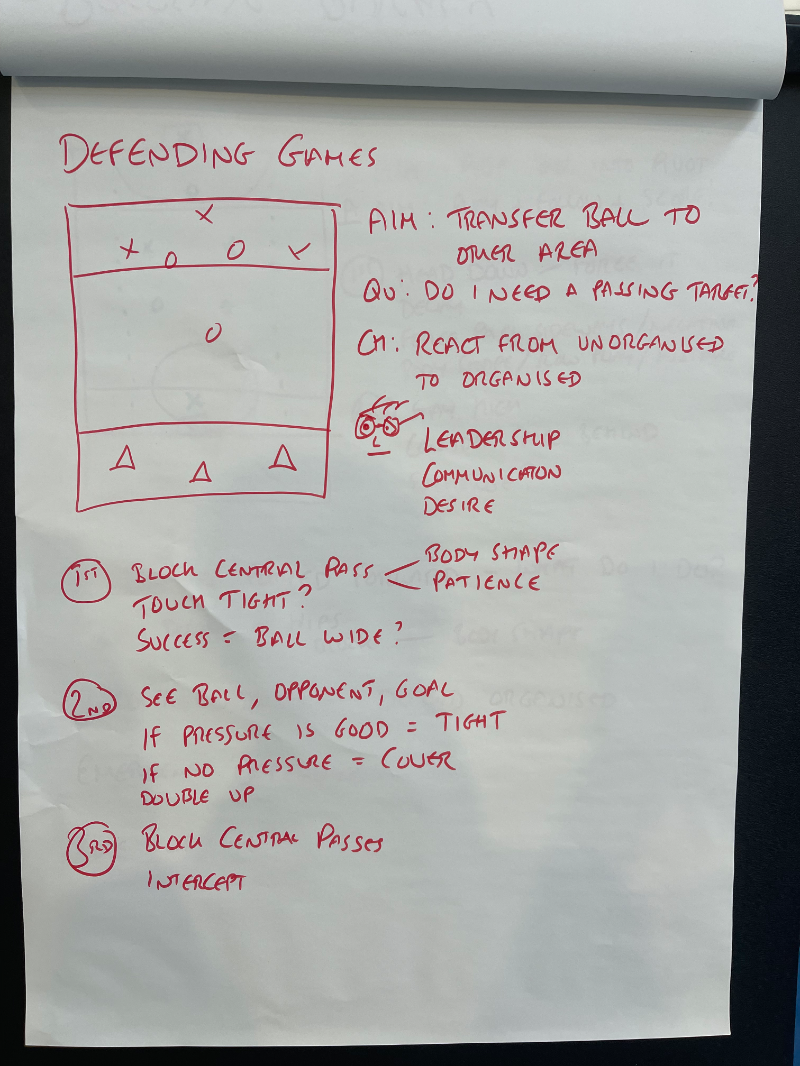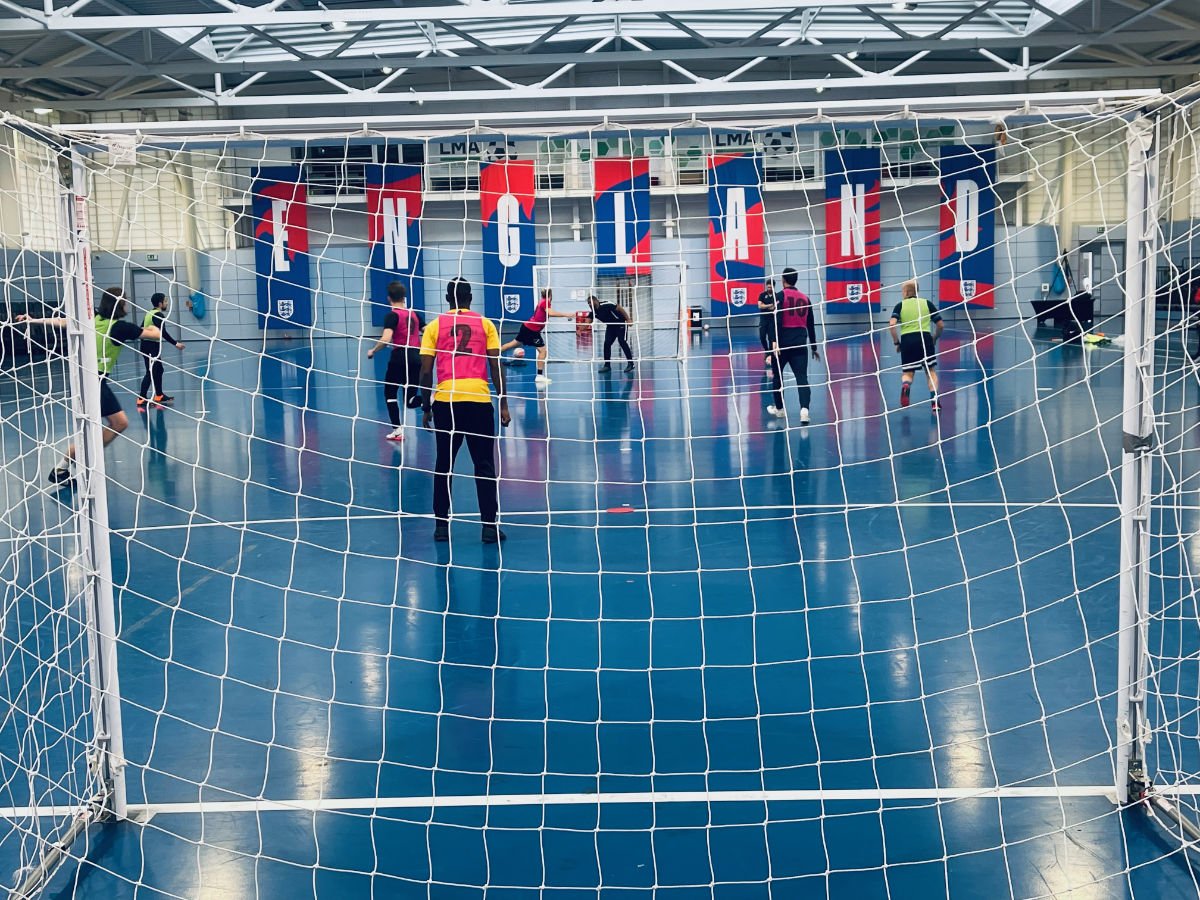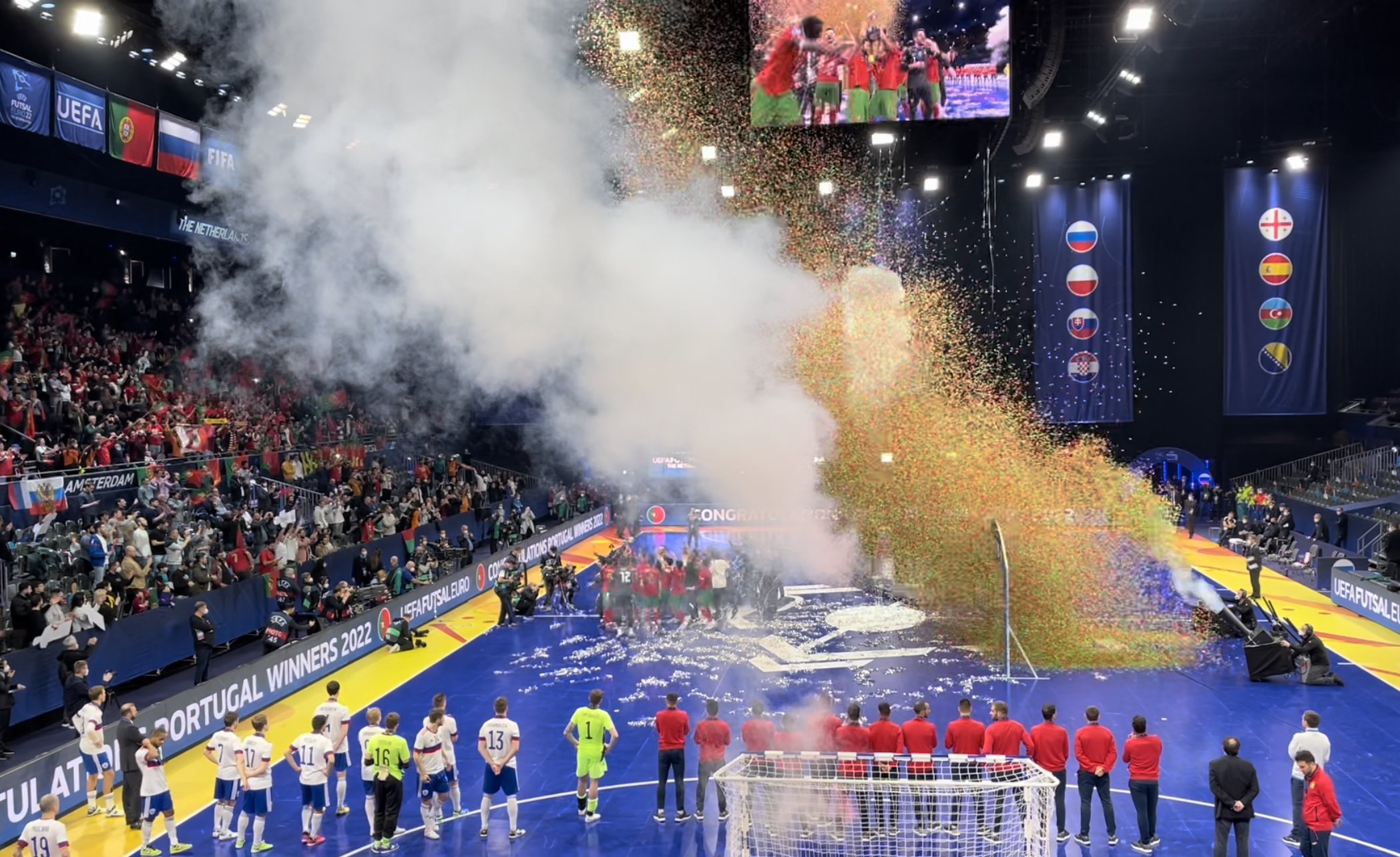Strictly come defending and the high art of pressing
Day two: Uefa B futsal coaching course
EVEN MANCHESTER United are at it now. “It’s intercepting,” explains Ian Parkes, lead FA tutor on the futsal Uefa B course, speaking to coaches at St George’s Park about “the first priority when defending”.
Defending comprises four “core skills”: pressing, marking, challenging – and intercepting, he explains.
The ability to press high to regain possession with goalscoring intent is the holy grail of modern football.
And futsal.
We’re sitting in the futsal hall examining the essential building blocks out of possession, which mirrors neatly the reverse focus on the fundamentals in possession from 1v1 up to 3v3 covered on day one.
Just 24 hours later, Ole Gunnar Solksjaer’s stalling, misfiring yet hugely expensive banger – aka Manchester United Football Club men’s first team – was cruelly rolled over by Jürgen Klopp’s relentless Liverpool juggernaut, a finely tuned engine of opportunism powering the motor of a flying, high-pressing ball-winning machine.
Ralf Rangnick’s debut at the Old Trafford wheel this week shows United are finally intent on joining the high-pressing party.
Pressing is about taking control when out of possession. And winning the ball back as swiftly as possible.
“Can we defend on the front foot? With anticipation, and try to win it first,” Parkes urges the coaches.
It’s a cultural shift, long prominent in futsal, that has intensified in football since the dawn of the age of Barcelona Pep-ball. The former Spain, Liverpool and Real Madrid midfielder Xabi Alonso summarised it neatly when he dismissed the fine English footballing tradition of tackling as a mere recurso (resource). “It’s a last resort,” he said in 2011. “You will need it, but it isn't a quality to aspire to.”
The skill to aspire to today is pressing, with interceptions and daylight ball theft as the objective. Whether that’s in a low defensive block with alarm-bell pressing triggers, a mid-press or the lower risk, higher reward strategy of employing traps to steal close to the opponent’s goal.
While most modern high-end football teams offer bursts of creative energy and output out of possession with a front three or four, in futsal it’s even more pronounced. High pressing is a fundamental strategy of every elite team. Involving three, four and often all five players.
The recent futsal World Cup in Lithuania, won by Ricardinho’s Portugal for the first time, offered a showcase to the power of pressing high – no surprise given the suffocating Y-formation approach that took the losing finalists, Argentina, to the title last time round in 2016. Every player must be able to join the press, hunting, covering, marking, supporting, and sniffing out weakness.
There’s no hiding space in futsal. And the game at the elite level is evolving, with lesser nations realising that physicality and energy out of possession can conceal markedly inferior technical and tactical nous on the ball and yield instant results.
Potent high pressing is futsal’s great disrupter.
Every player must defend with conviction and cohesion in a sport of constant attacks and counter-attacks.
Steal the ball, take the glory
“The punishment in futsal from just kicking the ball out of play is too severe,” explains Ben Tadmor, an FA regional talent centre coach and national team analyst assisting Parkes as tutor on day two. “You lose possession. So can we steal it and attack instead?”
This is the futsal paradox. Largely seen as an exciting game of risk, bravery and technical excellence, it’s all too often viewed through an attacking prism. How can we score? Where can we attack? What magic can we produce with the ball at our feet?
The acute defensive instincts and game nous honed by playing the game can be spectacularly underappreciated.
When I first started coaching kids in futsal over a decade ago, I quickly noticed the enhanced defensive awareness gleaned from playing the game while tailoring football training towards small-sided activities too. Forget “defending”. This is counter-attacking.
Steal the ball, take the glory. The kids would rise to the challenge. It’s one of the “hidden” aspects of the game I tried to cast a spotlight on when writing Futsal: The Story of an Indoor Football Revolution.
And all of it was apparent in the morning session at St George’s Park, which was devoted to games put on by six of the course candidates recapping the attacking fundamentals from day one by coaching a squad of energetic under 12s from Freedom 4 Futsal club in Worcestershire.
Rob Williams (Shrewsbury Town’s head of coach development) and 21-year-old Manchester futsal team player Ryan Williams went first with duplicate 3v3 games, one in each half of the court; Zed Mountford-Hill, a youth coach from Milton Keynes, and Loughborough national league player Jan Meiwald put on a half-court practice; and Mario Petruccio, a youth coach from Harlow, Essex, and John McDougall, an England partially sighted team veteran, cajoled the kids through a whole-court counter-attacking game.
Throughout the games, every attacking action enforced multiple defensive reactions. Every player knew they had a role they didn’t have the ball. It’s the power of small-sided games. The power of futsal, where all players on court are constantly engaged.
So if interceptions are the first priority when pressing, how do coaches help players improve the skill?
Just like on day one, working on in possession, we’re encouraged to think about the three phases for individuals: before, during and after, relating to defending, with a particular focus on “before”. This includes scanning (in the same way as a player awaiting a pass will search for information) and seeing the picture. Who’s got the ball? Where are they looking? What is their bodyshape (hips and eyes) telling me? Where’s my opponent? Where’s the space, the danger? The ability to read the triggers and cues ready to intercept and steal the ball is a skill. Xabi Alonso might say it’s an art. And putting players in a practice where they gain repetition of realistic opportunities to develop this skill and judgment is what we’re here for as coaches.
Through various 1v1, 2v2 and 3v3 games, we cover the principles of defending. If we want to improve the “before” aspect, we need practices with at least 2v2 otherwise there’s no passer to read and assess in an attempt to gauge when/where/how to try to steal the ball. With a straight 1v1 there is no “before” moment to assess.
So what were the biggest learning points of the day?


Uefa B day two: 5 key coaching points
The summary…
Pressure on the ball: Good pressure or poor? How do covering players react?
Triangle of perception: can a defender keep the ball and their direct opponent in their field of vision?
Strictly come defending: the jig of intent, probing, dancing, ready to pounce
Know your place: what’s the definition of success at that moment on the court?
The 50% player: why the goalkeeper counts for more in futsal
Pressure on the ball
In the afternoon session, we played a 3v3 pressing game – a waves practice put on by Ben Tadmor with each of three teams taking turns pressing an opposing trio by employing two advanced players and one defender locked deeper in a central zone.
The 3-player pressing priorities in a 3v3v3 waves game
Tadmor talks us through the priorities: the player closest to the ball presses. This is a defining principle of play. The second and third cover players react to events.
This is their “before” moment. If the first presser can’t steal, they try to put good pressure on the ball, affecting the receiver’s first touch by advancing at an angle and speed that takes control of the opponent’s options while the ball is travelling.
This delays progress, denies forward passing lines and can provoke panic or a risky pass or dribble. The quality of pressure on the ball (good or poor?) informs the second defender: good pressure means they can lock tight to their direct opponent. Poor pressure means it’s wise to stay deeper, covering for their team-mate in case they’re beaten 1v1.
A third cover player retreats centrally, covering the strong half of the court (the side where the ball is) if the ball is wide and remaining vigilant to intercept forward passes through the middle.
2. Triangle of perception
The cover players supporting the first press try to maintain the “defensive triangle of perception” so they can see the ball AND their direct opponent. This is vital. Whether deep and covering or getting tighter to their own opponent once the first presser has a good press on the player with the ball the same applies for a third cover player in a 3v3 situation when pressing high. Ball and direct opponent must be visible.
It’s a simple message that translates well to various parts of the court and is easily understood by all players on court and the coaches observing on the sidelines.
3. Strictly come defending
“Aggressive, aggressive,” roars Parkes. Repeatedly. In a particularly physically punishing 3v3 practice on a half-court. Thankfully, we played this one fuelled on the sustenance of the lunch provided in the Dugout restaurant in the football centre to make up for the stark lack of grub on day one.
(Sadly, however, the sit-down meal was a one-off. The course cost doesn’t cover lunch, I was told by an FA Learning spokesperson, despite the course literature not stating this explicitly. All of which leaves a slightly sour taste, if I’m being honest, given the £740 course is the top of the FA’s futsal coaching course tree and over many years “lunch provided” has been a standard addition to any similar level course at St George’s Park. Although we’re not getting fed again, we’re entitled to feed back, I’m assured, with our own nuggets to the FA.)
Ian Parkes, FA tutor, demonstrates aggressive ball-hunting against Ryan Jago in 1v1 moment
Anyway, back to the session: apart from “pressing”, “aggressive” was the word of the day for me. This exposes another misnomer about futsal. It’s actually a game of power and fight as well as guile and precision. In a 1v1 moment, facing up the attacker, Parkes demonstrates a crouching intent, legs bent, arms out, staring at the ball-carrier’s body shape and eyes, trying to dominate the opponent on the ball. “This is vital,” he says. “Especially in wide areas. Get aggressive … Don’t let them out. Steal it or force them off the court.”
One of the candidates, Luke Webb – an ex-pro footballer and director of football at Bradfield College in Berkshire – illustrates his own method of “pivoting” on one leg, while fishing for the ball in a 1v1 encounter, before thrusting off to snare the ball with the other leg. It’s an impressive skill. A rhythmic jig of intent. Strictly ball hunting, if you like.
Most coaches agree: it’s a viable skill, especially in wide areas, with the line acting as the extra defender. There’s a short debate about whether it’s appropriate centrally as the first pressing defender mid-court, when the priority for many futsal coaches would be to stop the ball being passed forward through the hallowed middle zone and not be beaten 1v1.
It’s a question of risk versus reward. A game of cat and mouse with the player on the ball. Parkes comes on court to show us his own version of Webb’s soft-shoe defensive shuffle. It takes two to Tango, after all.
“Get aggressive … Don’t let them out. Steal it or force them off the court.”
Defending is not just about the legs in futsal. The upper body is crucial. Parkes reminds players about the use of the “arm bar” to repel a runner off the ball. John Tapia Owens, head coach at London Bloomsbury men’s team, joins in with a bespoke method of blocking a runner – in accordance with the laws of the game, of course – who is trying to race forward down the line after releasing the ball. The physical dominance of opponents in 1v1s extends to off the ball.
All fascinating detail. Just like with the attention to movement nuances while defending: side shuffling beats backwards running for balance and awareness; be careful not to step across to block a shot by reaching with the foot farthest from the ball – it can unbalance a defender, leaving them unable to shift direction quickly; approaching a ball-carrying opponent’s dominant foot helps “take control” of their options.
4. Know your place
“It’s about where you are on court – and what you’re trying to do,” whispers Tapia Owens. “Your principles.” It’s a break in play and the head coach at London’s Bloomsbury Futsal Club is explaining to me his view on whether one of the defenders on court in front of us was correct to try to press an opponent striding forward with the ball just over the halfway line.
In this case, it was a 1v2 defending outnumbered practice. And the priority is to delay the opponent (in a more realistic game, his teammates would be making rapid recovery runs). Then it’s to drop deep (about 8-10 metres out is good) to kill the space available for the opposition to exploit but not so deep that a shot becomes inevitable.
Then it’s about turning the potentially perilous 1v2 situation into a 1v1 by blocking off the passing line to the extra attacker and engaging the ball. Aggressively, of course. The decisions, aims and actions while pressing high, with a full complement of team-mates composed and covering for you, will look very different. “Think about what ‘success’ means at that given moment,” adds Tadmor.
On the front foot: goalkeeper Ize Nicholls edges out of his area, covering and ready to intercept
5. The 50% player
In futsal, the goalkeeper is often the most important player on the court. It’s one role; 20% of the on-court team. But they must boast a full range of tools in their box, the sort of dynamic flexibility (physically and positionally) that automatically boosts their proportional impact on the team’s effectiveness to more like 50% in my experience.
Stopping shots, starting attacks, shouting instructions, quelling and creating chaos in one moment – and of course flying forward (as an extra attacker) in the opposition half in a 5v4 powerplay. The 1v2 defensive practice highlighted the keeper’s importance. It’s not really a 1v2 at all. It’s 2v2, with the defender and keeper employing the same principles of 2v2 defending (first player presses the ball, second retains the triangle of perception while offering depth and cover).
This comes out loud and clear when a lone defender fails to stop a switch of play to the far-post attacker. In futsal, the bypassed defender should stay with the passer, blocking and covering their run – maintaining the “triangle of perception” – while allowing the keeper to bolt out and engage the attacker with all the power and physicality required to block the route to goal and snuff out the danger.
Thankfully, we have Dylan Malpas on the course. The Worcester Futsal Club keeper and former England international is quick to let us know his thought processes while his team-mate is engaging the ball. The other goalkeepers during two breathless 3v3 practices – the Northern Ireland futsal coach Ciaran Donaghy, Tapia Owens, and Ize Nicholls, coach and founder of Balham Ballers in south London – all respond to the urgings to bolt out ready to steal the attacker’s space. And ideally the ball. It’s where the counter-attack begins.
Uefa B day one: “It’s where the magic happens”: why small is beautiful in futsal
Have something to share? Add your comment below.
















MIGUEL RODRIGO is ready for his last dance with Thailand. The globe-trotting Spanish tactician reveals his futsal inspirations plus hopes and predictions for the World Cup in Uzbekistan